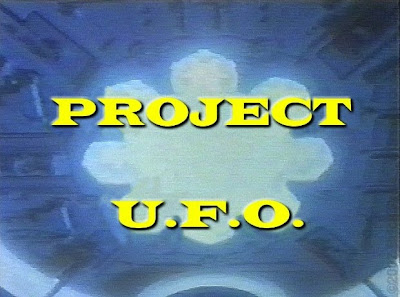
PROJECT U.F.O.
(1978, USA, TV)
In 1978, the double-whammy of box office hits, Star Wars and Close Encounters of the Third Kind, had sparked a sci-fi explosion on TV. But while Star Wars directly inspired the galactic dogfights of Battlestar Galactica and Buck Rogers in the 25th Century, what could TV do with Close Encounters?
The answers lie in Project Blue Book, the USAF official catalogue of the investigation of UFO sightings in the USA, also the inspiration for many events in Close Encounters. In the first episode of Project U.F.O. ('The Washington DC Incident'), UFOs descend near a woman alone in a remote country house, buzz a guy stranded in his pick-up truck late at night, and get tracked by a roomful of air traffic controllers - all mirroring major scenes from Spielberg's film.

After a jumble of sightings, two officers from the Air Force investigate and question all the witnesses. Sergeant Fisk and Major Gatlin are very limited characters, often sounding like they're spouting official USAF documents. Having said that, fair-haired Caskey Swaim is still easy on the eye. The hook to the series was a weekly dose of UFO sightings and alien visitations. These are imaginatively done, albeit on a TV budget (the models look far too small to be anything else than plastic kits). The parade of different extra-terrestrials, usually a new race every week, are more interestingly realised.
The twist is that some of the sightings can be explained away, others cannot. Though if you rewind to the footage of the reported sightings and compare them with the explanations, they don't always match up. When The X Files began, I thought that, like Project U.F.O., at least a few of the cases Mulder and Scully investigated would turn out to be hoaxes or natural phenomenon, rather than them striking paranormal gold every single week.

For the time, Project U.F.O. was a visual effects-heavy TV show, and still provides plenty of retro eye-candy. Looking past the special effects to the original cases that are described could prove to be a little spooky, if you get into it. Nowadays, it's hard to enjoy because of the lack of engaging characters. The level of logic and science is partly aimed at children, or at least anyone who's never heard of electrical storms and the planet Venus. The show is also remarkably low on interesting or even recognisable guest stars, Leif Erickson (of the original Invaders From Mars) and Pamela Franklin (The Legend of Hell House) being rare exceptions.

It's a stretch to call Project U.F.O. a forerunner to The X Files as it's too light in tone, with such slim storylines, (The Night Stalker was much more of an influence). It was also a steep contrast from the aggressive aliens, imaginative action and tight special effects of Gerry Anderson's UFO of almost ten years earlier.
Both seasons of Project U.F.O. reappeared on UK's Sci-Fi Channel a few years ago, so the series is still out there, but has never appeared on DVD anywhere. 26 episodes in all, has anyone spotted them recently? Keep watching the airwaves!
Here's the opening of the first episode on YouTube...




















